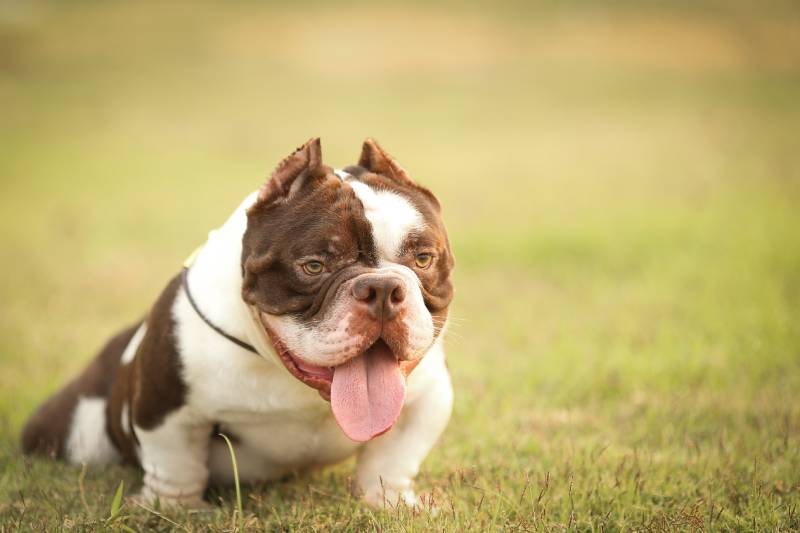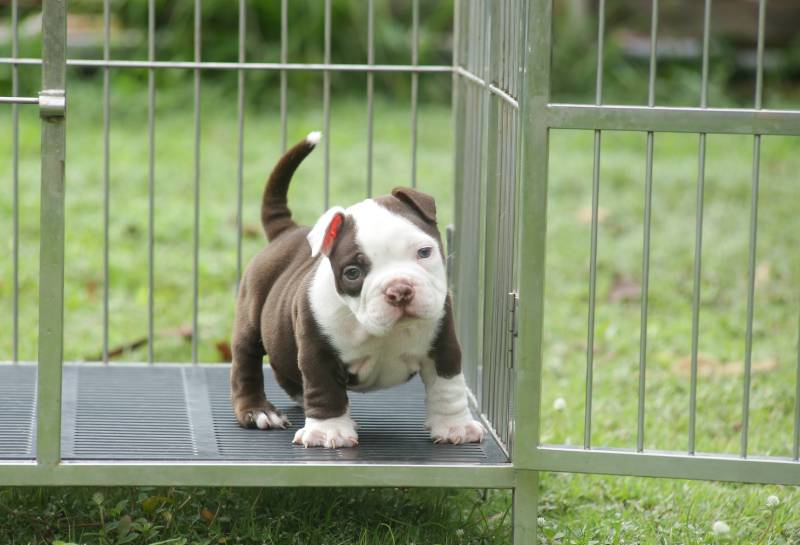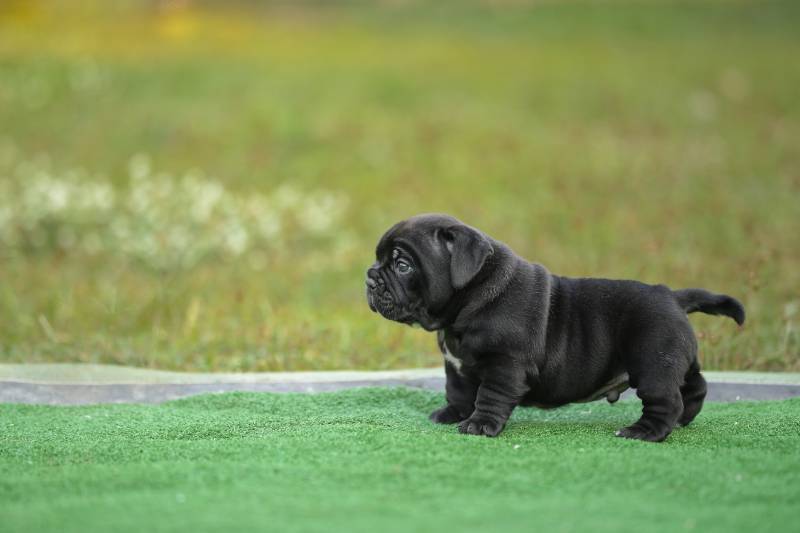Micro American Bully: Facts, Origin & History (With Pictures)
By Jordyn Alger
Updated on

Click to Skip Ahead
The American Bully is a popular dog, but they aren’t the right fit for every family. For example, those living in small apartments may find it difficult or impossible to house an American Bully. If you’re interested in the American Bully but need a smaller dog, you may want to check out the Micro American Bully.
The Micro American Bully is a miniature version of the American Bully. However, there is much more to this breed, which we will dive into below.
Breed Overview
| Height: | 10–12 inches |
| Weight: | 35–45 pounds |
| Lifespan: | 11–13 years |
| Colors: | White, black, chocolate, red, blue, black and tan, blue and tan, fawn, brindle, lilac, piebald, tricolor |
| Suitable for: | Moderately active families, families with older children, apartment or home living, households that can provide plenty of attention |
| Temperament: | Sweet-natured, social, confident, occasionally stubborn |
The Micro American Bully is a short-legged, barrel-chested canine with a large head and cropped ears. This breed’s unique appearance has earned the adoration of many bully enthusiasts, as has their bold personalities. The Micro American Bully is known for their playfulness, charm, and sass, but also their gentleness.
The Micro American Bully began as a designer breed in the early 2000s. Although they have a relatively short history, there is much to learn about this special canine. Below, we will discuss the breed’s rise in popularity, formal recognition status, and more.
Micro American Bully Breed Characteristics
The Earliest Records of the Micro American Bully in History
The American Bully was created in the 1990s, primarily along the east and west coasts of the United States. The dog was developed by crossing the American Pit Bull Terrier, the American Staffordshire Terrier, and a handful of other breeds. The purpose behind breeding the American Bully was to create the ideal family companion.
From the beloved American Bully came the Micro American Bully. By breeding other, often smaller Bully breeds with the American Bully, the Micro American Bully was born. While the Micro American Bully was initially considered a smaller version of the American Bully, they are now widely recognized as a separate breed. This is due to the significant differences in phenotype between the American Bully and the Micro American Bully.

How the Micro American Bully Gained Popularity
The American Bully was designed primarily to be a family dog, and the Micro American Bully is much the same. The Micro American Bully has grown in popularity in recent years due to their stout stature, unique appearance, and pleasant personality.
However, a surge in popularity isn’t always a good thing. In the case of the Micro American Bully, unethical breeders can take advantage of the dog’s popularity and attempt to breed as many as possible without considering the litter’s health.
Some inbreed their Micro American Bullies, which can lead to significant genetic issues down the road. Therefore, when searching for your Micro American Bully, you must do careful research before deciding on a breeder.
Formal Recognition of the Micro American Bully
The Micro American Bully and American Bully are not officially recognized by the American Kennel Club (AKC). However, the American Bully is officially recognized by many Bully registries, such as the American Bully Kennel Club (ABKC).
The ABKC recognizes four varieties: Standard, Classic, XL, and Pocket. Sadly, the Micro American Bully is not among them. Currently, that is the case for many other Bully registries.
However, many Micro American Bully enthusiasts believe that the differences between the American Bully and the Micro American Bully are obvious enough to warrant the Micro American Bully being their own breed. With time, it is possible that more Bully registries will begin to recognize the Micro American Bully formally.
Top 4 Unique Facts About the Micro American Bully
1. Micro American Bullies Are Considered Controversial
As adorable as these tiny canines are, the Micro American Bully is considered to be controversial. This is largely due to their status as a designer breed. Some designer dogs are susceptible to unethical breeding practices, which can cause them to develop significant health issues.
2. Micro American Bullies Can Be Expensive
Micro American Bullies are not the easiest breed to find or the cheapest to bring home. Some Micro American Bullies can be sold for prices as high as $20,000.

3. Grooming a Micro American Bully Is Easy
An appealing part of owning the Micro American Bully is how easy they are to groom. With their short, smooth coats, the Micro American Bully requires consistent yet infrequent brushing. They also don’t need to be bathed too often; a quick wipe-down with a wet washcloth can be enough.
The tricker parts of grooming a Micro American Bully involve cleaning their ears and brushing their teeth. While such grooming care may seem daunting, it is essential to preventing ear infections or dental diseases.
4. Early Socialization Is Essential
The Micro American Bully are known for their playfulness and gentleness, but they may be prone to aggressive behaviors without early and adequate socialization. Therefore, it is essential that you introduce your Micro American Bully to new people, pets, environments, and situations early on in life so they can adapt.
Likewise, attending obedience training courses with your Micro American Bully will help you to keep your canine in check in high-stress situations.

Does the Micro American Bully Make a Good Pet?
The Micro American Bully’s adorable appearance and lively personality make them an excellent pet for all family dynamics. They don’t require vigorous exercise and are happy to go on brisk walks or snuggle up on the couch. They thrive on attention, making them great companions for those who are often home.
Micro American Bullies can be stubborn, which can make training a hassle. However, training should never be neglected, especially with the Micro American Bully. Time, consistency, and patience will be your friends when teaching your Micro American Bully proper behavior.
Never resort to punishments or harsh correction methods; otherwise, you may fray your Micro American Bully’s trust in you. Instead, focus on positive reinforcement and reward-based learning.
Micro American Bullies are friendly dogs that do best with older children who understand proper behavior around pets. All interactions between children and your dog should be carefully supervised to ensure that no one’s boundaries are being trampled.
Many dog lovers enjoy the company of the Micro American Bully. If you want a unique and friendly canine companion, the Micro American Bully could be perfect for you.
Conclusion
The Micro American Bully is a designer dog with features that resemble the American Bully; however, the breed has developed unique qualities. While most canine registries do not formally recognize the Micro American Bully, many Bully enthusiasts assert that the dog is unique enough to deserve recognition.
While the Micro American Bully is surrounded by controversy, it is impossible to deny that the dog possesses several positive qualities. The Micro American Bully is a gentle, social, and confident companion, making them an excellent friend for families.
Featured Image Credit: Chatuphon Nachanta, Shutterstock














